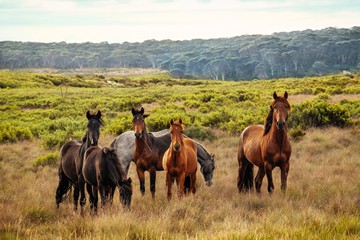This submission is a response to the invitation by Parks Victoria to provide feedback on the Protection of the Alpine National Park: Draft Feral Horse Action Plan April 2021.
The draft feral horse action plan 2021 follows the Protection of the Alpine National Park – Feral Horse Strategic Action Plan 2018-21, and focuses on how feral horses will be managed in the Alpine National Park and adjacent state forests over the next ten years, from 2021.
Since the original action plan was released in June 2018, significant changes to the context of managing feral horses in the Victorian Alps have occurred, requiring reconsideration of the methods for their management.
The Invasive Species Council has been concerned about the lack of action in regard to removing feral horses over the past three years due to legal challenges, offensive and belligerent actions from some in the community, logistical challenges and the reliance on ineffective methods such as trapping and rehoming in the existing Feral Horse Strategic Action Plan 2018-2021.
During this time the feral horse population has been increasing at around 15% a year or more while the alpine environment struggles to recover from the impact of drought and landscape-scale bushfires.
The action plan presents the threats from feral horses to ecosystems, catchments and cultural heritage but fails to address the potential risk to biosecurity from spread of disease such as equine influenza, strangles and anthrax, which can be serious threats to domestic horses and contamination of drinking water from Cryptosporidium.
The Invasive Species Council welcomes a fresh approach to control methods, including the allowance of ground and aerial shooting. These have been clearly demonstrated as the most cost efficient and effective control methods and when carried out professionally have the best animal welfare outcomes. The emotive arguments put forward against these methods have no foundation in evidence and have led to unacceptable impacts of feral horses continuing in the Alps for far too long.
We are concerned the plan lacks goals, commitment and ambition in delivering on the objectives. Actions such as “to remove sufficient horses to reduce ecological impacts” are imprecise and statements such as “in the eastern Alps, feral horses are considered beyond eradication” indicates a poorly argued willingness to allow feral horses to remain in the Alpine National Park.
While the re-enforcement of the long-held strategy to eliminate the feral horse population in the Bogong-Cobungra area is welcome, the plan doesn’t address why feral horses should remain in the Eastern Alps, albeit in lower numbers. The plan acknowledges that while feral horses are present, ecological asset protection will be required.
The biosecurity approach to invasive species management clearly shows the high-cost implications of allowing a population of feral horses to remain in the containment and asset protection phases.
Summary of recommendations
Eradication of feral horses
- The goal of the feral horse action plan must be to eradicate the population of feral horses in the Alpine National Park over no more than a 10-year period and prevent re-introduction. This is entirely feasible through an integrated ground and aerial shooting program. To not do so in a national park when there is the opportunity is indefensible.
- The feral horse population in the Bogong-Cobungra area must be eliminated as a first step to eradication of feral horses from the park within 10 years.
Methods
- The introduction of aerial and ground shooting to cull feral horses in the Alpine National Park is fully supported as this is proven to be the only effective methods available.
- Shooting must only be conducted by professional shooters and pest controllers. The program cannot be compromised by the actions of non-professionals.
- Community benefits through capture and rehoming of feral horses on a limited basis as described in the plan is supported. This program must be implemented cautiously and not divert attention from rapidly applying more effective measures. Trapping and rehoming is merely a social response to the problem and is not effective in reducing the impact of feral horses.
- Aerial shooting must not be used in a limited way in response to “exceptional circumstances or if other methods cannot meet objectives”. Due to the nature of the terrain, particularly in the eastern Alps, ground shooting will not be feasible across much of the landscape and will not meet the number reduction required. Aerial shooting must be an equally preferred method to ground shooting from the start for inaccessible landscapes, as is the case with Parks Victoria’s current integrated shooting control program for feral deer.
- Parks Victoria must develop an intensive education program with the community to present the rationale for why feral horses must be removed from the Alpine National Park, the ineffectiveness and inhumane issues associated with “passive methods” and the humane nature of ground and aerial shooting.
Strategy
- The annual population reduction rate of feral horses must be at least 45% of the extant population per annum to come close to elimination by year 10.
- The plan should map the biosecurity zones and provide a schedule based on population estimates, locations and potential fecundity to determine the number of horses that need to be removed annually over a ten-year period to eliminate the population.
Disease
The plan should address the risks of disease spread from feral horses.









